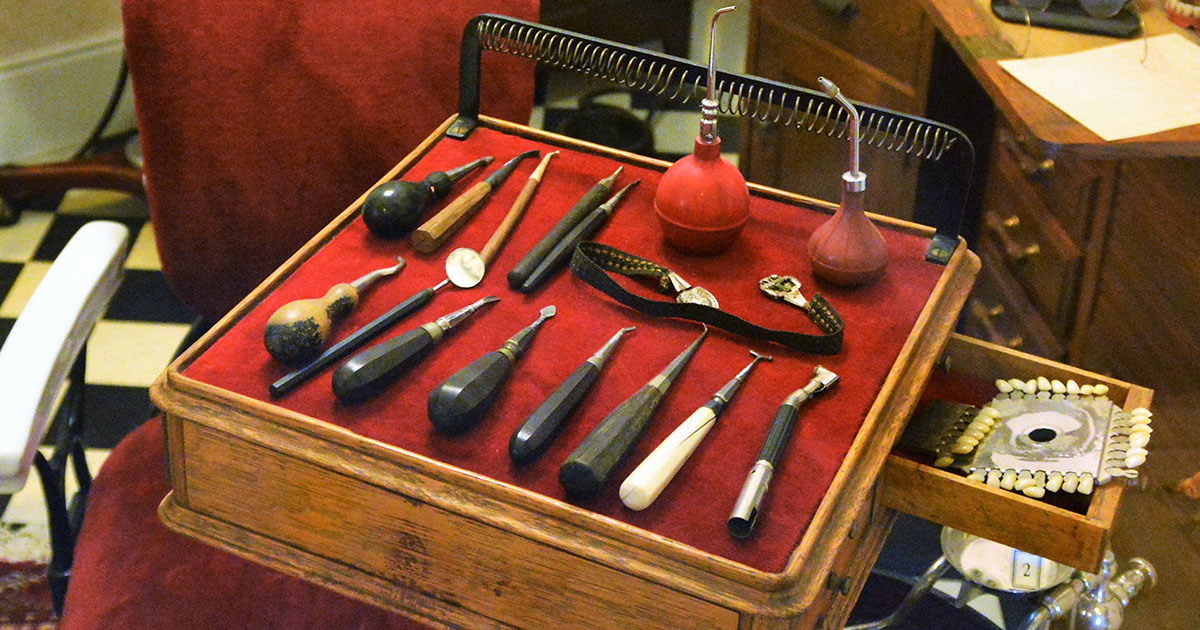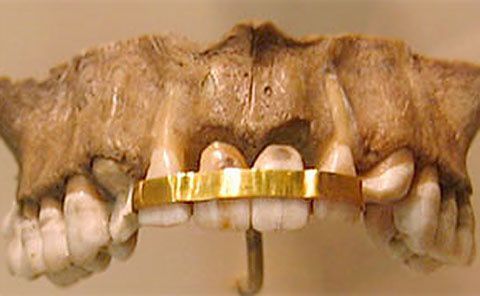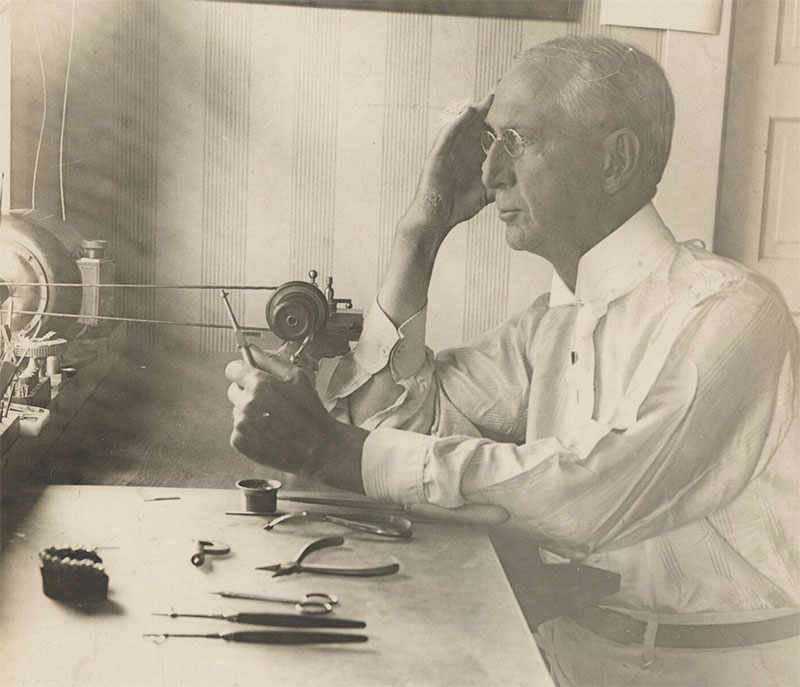Ever wondered where braces originated? We did, too – and it turns out that braces have an extensive, fascinating history.
In fact, the recorded history of braces spans 5,000 years, from rudimentary thread made of catgut to string teeth together to modern metal braces and Invisalign. For those with misaligned teeth or other orthodontic issues, braces have been a game-changer in achieving that perfect smile we all strive for. If you’ve been wondering how braces have evolved over time, we’ll take you on a fascinating journey through the history of braces, from their ancient origins to the modern orthodontic marvels we know today.
Who Invented Braces?
The idea of straightening teeth has been around for a long time, but no civilization or person has ever been named as their official inventor. Ancient Greek philosophers such as Aristotle and Socrates theorized ideas for straightening teeth, although it’s unclear if it was for cosmetic value or another reason. Still, the idea was prevalent within Ancient Greek culture.
The Etruscans, who predated the Romans, show evidence of bearing gold bands on their teeth, thought to preserve the teeth post-mortem. It’s incredible to think of the technology these ancient civilizations created in order to achieve straighter teeth. Let’s follow the story of braces through history and get a better idea of which societies originated the components of braces we know today.
A Short History of Orthodontics
Ancient Civilizations: The Egyptians, Etruscans, and Greeks
Ancient Egyptian mummies have been found with evidence of orthodontic treatments in their mouths. These primitive treatments were made up of a string-like material made of catgut and brackets made from metal that wrapped around individual teeth. These familiar components appeared to work much like braces do today.
As mentioned, the Greeks were fascinated with the idea of straightening teeth and the appliances that could be invented to do so. By contrast, the Etruscans mainly used orthodontic practices to help preserve the teeth of the deceased. They placed a gold disc between the teeth to keep them aligned in the mouth in death.
French Renaissance
Unfortunately, there was a large gap in written records and advancements in orthodontia during the Dark Ages. As a result, it wasn’t until the French Renaissance that we saw the birth of modern orthodontics. Pierre Fauchard, who is dubbed the father of dentistry, invented the “bandeau,” which is the first recorded piece of dental equipment. The bandeau was a strip made of metal that was worn around the chin. It was created to help make the teeth straight and the dental arch taller. However, it didn’t quite catch on because it was uncomfortable and expensive. This invention did inspire a new field in orthodontics, though, and many more people continued to invent new ways to straighten teeth.
In 1757, another early orthodontist named Pierre Bourdet discovered that removing the wisdom teeth prevented overcrowding in the mouth. He also improved and expanded upon the bandeau to create a more comfortable design. An alternative method to combat overcrowding was using threads and wooden wedges to pull teeth apart instead of pulling them out. As you can see, the French dentists of the 18th century made significant headway in the field of orthodontia and invented many basic components of our modern braces today.
19th Century in America
In the 19th century, orthodontia started to become a specialty separate from traditional dentistry. In the meantime, Americans built on the advancements of the French and developed several breakthroughs in the field of orthodontics – most of which are still used today in orthodontic practice. In 1822, the occipital anchorage was invented by J.S. Gunnel. This device is similar to a night brace or headgear seen today, which is worn outside the mouth and lightly applies pressure to change the position of the teeth over time.
In 1843, Edward Maynard began using elastics to realign the jaw. The precursor to rubber bands still seen today, elastic was connected to the wires to slowly move the jaw into proper alignment. Then, in 1846, E.G. Tucker took the recent invention of vulcanized rubber a step further. He was the first dentist in America to utilize rubber bands in orthodontic appliances. In 1893, Henry A. Baker furthered the use of elastic bands to force overcrowded teeth apart so there was space to fit the wire bands around the teeth. Previously, the common solution was to pull out teeth to make space.
20th Century Era of Orthodontics
In the 1900s, Edward Angle invented an orthodontic bracket that could be affixed directly to the tooth versus the band that previously wrapped around the tooth. Angle also developed the classification system that defines the varieties of misaligned teeth, which is still used today. He is also credited for founding the American Society of Orthodontia in 1901, later renamed the American Association of Orthodontists in the 1930s.
During this time, braces transitioned to stainless steel construction as opposed to the gold or silver options of previous decades. This made braces as an orthodontic treatment more affordable for patients while also giving orthodontists more flexibility.
By the 1960s, NASA’s space program contributed to the development of a revolutionary material used in braces—nickel-titanium alloy. This special wire, also known as “Ni-Ti” or “nitinol,” was initially created for the space agency because of its unique properties, including its ability to return to its original shape when heated. Orthodontists then adopted nitinol because it provided a more constant force of pressure for the individual tooth movement and reduced the need for frequent adjustments compared to traditional wires. This allowed orthodontists more flexibility in treatment plans and gave the patients more flexibility to schedule their visits.
The 1970s and 80s saw several advancements in X-ray technology and 3D dental imaging that also changed the orthodontic field. Dental impressions allow orthodontists to see every angle of the tooth, which helps them better create treatment plans. These technologies all help orthodontists better treat their patients and provide them with the appropriate care.
Lingual Braces, Clear Aligners, and Invisalign
Lingual braces were developed in the late 1970s. This type of braces attaches to the back of the teeth versus the front plane of the tooth. This method offers a more aesthetically pleasing look than other styles, but many people prefer not to have their brackets affixed to the back of the teeth.
Clear aligners, on the other hand, are an alternative teeth straightening technique that is often a more desirable option for teens and adults. Clear aligners are transparent and offer a more discreet way to straighten teeth. They also make the experience of braces more comfortable with the smooth surface of plastic as opposed to metal brackets.
These systems, most notably Invisalign, have been around since 1997 but have been steadily increasing in popularity since 2000. Invisalign has become the industry standard for quality clear aligners. Over ten thousand people have used the Invisalign system, including many celebs who have used both Invisalign and traditional braces as kids and into adulthood.
How Modern Braces Actually Straighten Teeth

While all braces throughout history were developed to shift teeth back into place, modern braces work by exerting constant pressure on the misaligned teeth. The individual brackets are glued to the teeth and then connected to the archwire, which is the part that moves as the teeth are pulled and straightened. Depending on the diagnosed issue and reason for the braces, the time needed with the braces can vary.
Fixing an over or underbite is a little different than misaligned teeth because the jaw is what is moving, not just the teeth. The usage of elastics is beneficial to this process, as they pull the jaw to where it needs to be to address the bite issue. No matter the issue, though, you can count on your modern braces to move your jaw or teeth much more efficiently and comfortably than their historical counterparts.
How to Care for Modern Braces
If you wear braces, it is important to care for them to ensure they are doing their job efficiently and effectively. Any wire breakage or bracket loosening should be fixed immediately by your orthodontist. If you do feel a bracket rubbing against the inside of your mouth, using dental wax is a great way to coat the bracket to avoid irritation until you can get the issue addressed by your orthodontist.
Dental hygiene arguably becomes more important with the addition of braces to the mouth. Regularly brushing your teeth for at least two minutes is recommended to clean the braces of any leftover food. Food is more easily caught in the grooves and spaces between the braces brackets and can cause further dental hygiene issues if braces are not properly cleaned. Flossing is another method to clean between braces, especially around the back molars. If a good flossing regimen is not implemented during braces usage, people find that they have more plaque buildup or even discoloration after having the braces removed. Try a braces flosser or waterpik to improve your flossing routine.
Orthodontics, Looking Forward
Having straight teeth can contribute to good overall dental health. Straight teeth allow your jaw to chew and bite food correctly, which decreases jaw pain. Being able to enjoy every meal without pain or discomfort is a significant benefit to be gained from having straight teeth. Jaw pain is one of the biggest reasons people seek out orthodontic treatment, and braces can be an excellent solution. Proper alignment can also prevent plaque buildup and other types of dental issues.
In an effort to address these issues, there are consistent improvements made in orthodontia to increase the effectiveness of treatments and provide patient comfort. As technology continues to advance, we can only imagine what the future holds for orthodontics. One thing is for sure: the quest for the perfect smile will continue to drive innovation in the field of orthodontics, making braces even more effective, comfortable, and accessible for generations to come.
Do You Need Braces?

As mentioned, there are many reasons you may be in need of orthodontic treatment, but if you’re not sure whether or not you need braces, seeing an orthodontist is always the first step. Contact Robison Orthodontics today to book an appointment and get a professional opinion on the best course of action for your smile. We are proud to serve the Valley Area with the latest orthodontic technology and cutting-edge techniques.

Dr. Tyler Robison is an alum of Mesa’s Mountain View High School. He graduated from Brigham Young University before being accepted to the “Top Ten-nationally ranked” University of Louisville in Kentucky, where he earned his Doctorate in Dental Medicine and a Master’s Degree in Oral Biology. He graduated with honors in the top ten percent of his class. Dr. Robison continued at the University of the Pacific in San Francisco, where he received a second master’s degree in dental science and his orthodontic certification.




